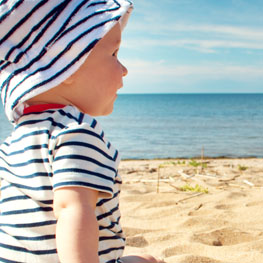
Beaches, parks and back yard play: Summer is about fun in the sun. But there’s nothing fun about a sunburned baby. Little ones are especially vulnerable to the sun’s burning rays. According to the Skin Cancer Foundation, a single blistering sunburn in childhood more than doubles the risk of developing melanoma later on in life. The American Academy of Pediatrics (AAP) reports that most parents aren’t doing enough to protect small children from sunburn; sunscreens are often applied incorrectly, leaving little ones exposed to skin damage. Here’s how to keep your little one happy and safe this summer.
The label game. With everything from creams and sprays to goggles and glasses boasting ‘sun protection,’ labels can get confusing. The acronym, SPF, stands for Sun Protection Factor, and it represents the amount of time the product protects skin from burning.
The Ultraviolet Protective Factor, or UPF, refers to the amount of ultraviolet radiation that reaches the skin. When choosing sun-safe products (especially for babies), look for an SPF of at least 30, which keeps skin unburned 30 times longer than skin without protection. According to the Skin Cancer Foundation, “the higher the number, the better [protection].”
Made in the shade. Babies burn more easily. They are not born with a developed skin protection system, and have sensitive skin that is thinner than an adult’s skin. For babies under one year, the safest sun is no sun at all. As per the Dermatology Association, keep babies out of direct sunlight either in a stroller with a hood or a canopy, under an umbrella or in a heavily shaded spot. Limit being outside for long periods of time between 11am and 4pm, especially around noon.
Sunblock shock. Most babies over two months old can safely wear sunscreen (but again, babies this young should be kept out of direct sunlight). But choosing the right one can frustrate even the most label-savvy parent.
Some sunscreens and other products that contain sunscreens, approved by the Dermatology Association, include Aveeno Baby Sensitive Skin SPF 50, Coppertone Kid Sunscreen Lotion SPF 60, Life Brand Sunthera 3 Baby SPF 60 and more. For the complete list of the Dermatology Association’s recognized sunscreens and other products containing sunscreens for babies and children, visit dermatology.ca.
Natural sunblocks contain zinc oxide or titanium dioxide, ingredients commonly used in diaper rash creams and well tolerated by most babies. These physical sunblocks actually block UV light, creating a protective barrier on the skin.
Conventional sunscreens (also called chemical sunscreens), like those made by Coppertone, work in another way by absorbing UV light. Either type works well; conventional and physical sunscreens can also be layered to create a more effective, lasting sunlight barrier.
Use a sunscreen with an SPF of 30 that protects against UVA and UVB. Apply sunscreen to your baby before leaving the house; the UV filters need 20 to 30 minutes to form a protective layer on the skin, and sunscreen won’t adhere as well once your baby gets sweaty or damp. Always reapply sunscreen, even those marked ‘waterproof’ after swimming and toweling off. And don’t forget these commonly burned hotspots: the nose, the head (particularly on fair-skinned babes or those without hair), and the tops of the hands and feet.
A small amount of sunscreen may be applied to exposed areas of the skin that are not covered by clothing such as the face, neck and the backs of the hands. And always test a small amount of sunscreen on baby’s inner arm before use. Check for a reaction up to 48 hours later.
Remember, sun protection is needed whenever the UV Index is 3 or greater.
Functional fashion. Photoprotective clothing is a boon for babies, especially when parents are leery about applying sunscreen to small infants. Lightweight, long-sleeved clothing can offer protection from the sun’s rays, but take note: a basic white cotton tee only offers a UPF value of about 7. Tightly-woven, darker fabrics let through less sunlight, therefore offering more protection. Denim, canvas and fabrics labeled with a UPF value of 30+ are good bets. To increase the shade-factor in your baby’s wardrobe, look for a laundry additive called Sun Guard. It contains the protective agent Tinosorb, which ramps up UPF value of clothing and lasts through 20 washes.
Look for sunhats with a brim of at least three inches, sunglasses that wrap around the child’s face (wraparound shades increase sun protection by 5 per cent) and a long-sleeved cover-up for baby to wear once pool time is through. And again, don’t forget your baby gear and accessories: Your stroller’s umbrella, your baby carrier’s hood and a receiving blanket tucked into your diaper bag can offer extra protection to help keep your summer sunny side up.
Malia is a nationally-published journalist, and a mom of three. Her latest book is Sleep Tight, Every Night: Helping Toddlers and Preschoolers Sleep Well Without
Tears, Tricks, and Tirades.
Calgary’s Child Magazine © 2024 Calgary’s Child